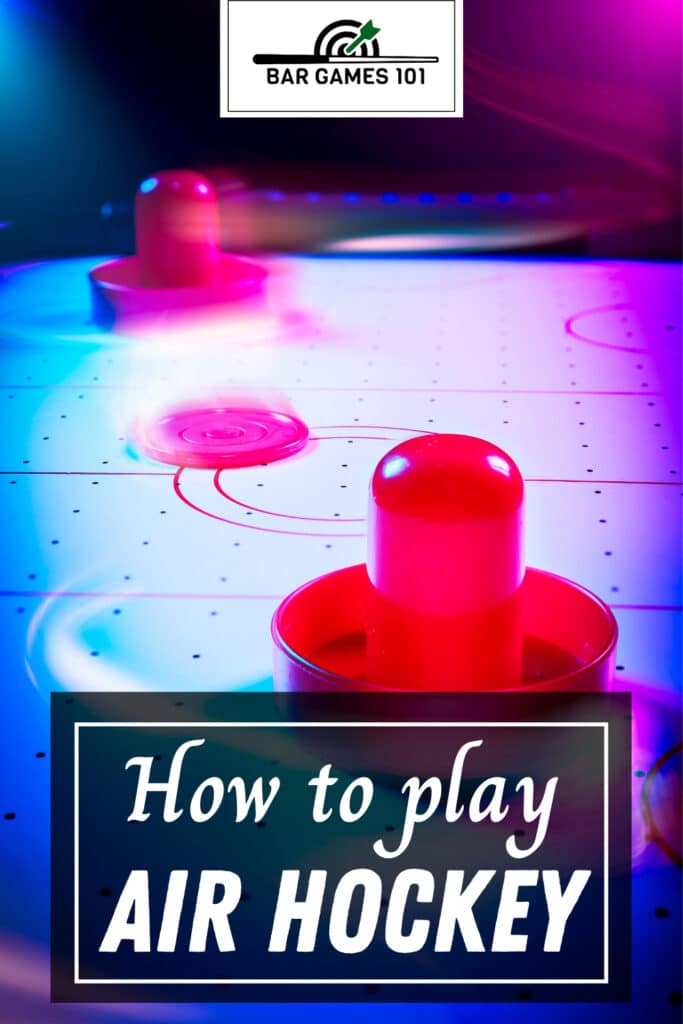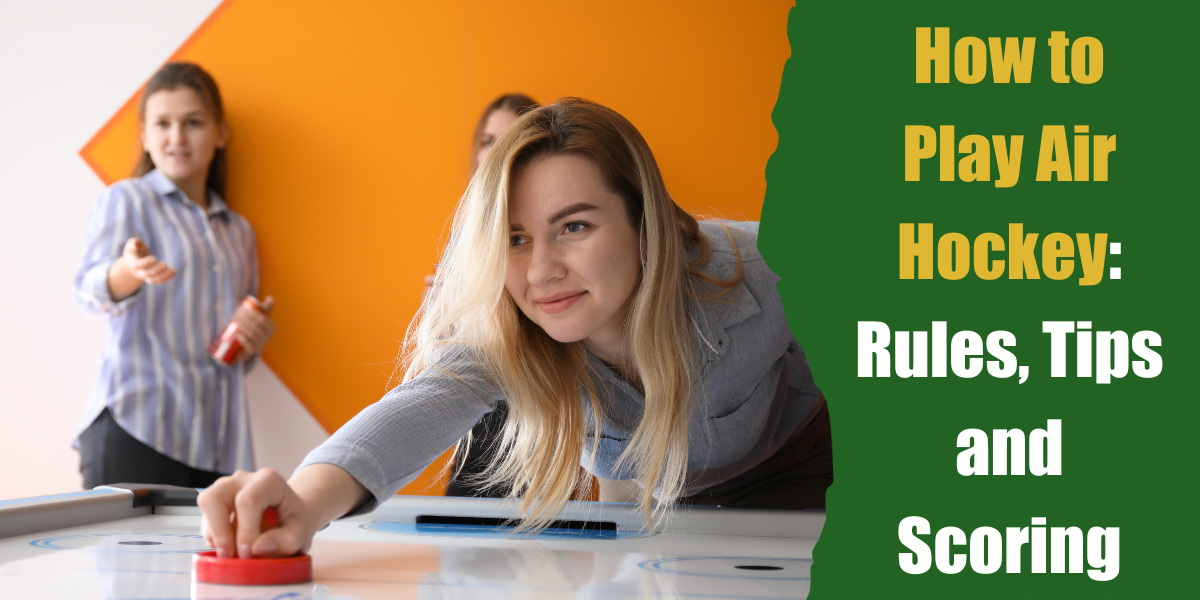Air hockey is one of those bar games you can just pick up and enjoy, without any real knowledge of the basic rules.
But if you play often and even somewhat competitively with friends, you’ll want to refine your mallet skills and learn a few tips from the pros.
To help you out, this post provides a refresher on how to play air hockey, including an overview the basic rules, scoring, penalties and some tips to improve your skills.
(That way you can at least call out your friend, I mean opponent, on their fouls.)
Start the Game!
With a simple coin toss, players will determine either:
- Who starts off in puck possession
- The side of the table to begin
Either way, the player with the puck also begins games 3, 5 and 7 with the puck, alternating with the opponent, who begins games 2, 4 and 6.
Know the Basic Rules of Air Hockey
Players have one mallet on the playing field. (Although it’s a heckuva lot of fun to double fist.)
Pucks can be struck with any part of the mallet, but never “topped.” And only one puck is allowed on the playing field.
Serves fall upon the player scored upon, and whoever is in possession of the puck.
Stand behind the center-line of the table on your respective side, and never beyond.
Alternate Sides – After each game, players switch sides to keep things interesting.
Time Outs – Only one time-out per game, which is allowed for no longer than 10 seconds and only when the puck is in their possession or (obviously) not in play. A second time-out may be called, but only upon injury.
No products found.
Know When You’ve Scored!
The first player to gain seven goals is the winner. But if you’ve played air hockey before, you know there are always questionable (and debatable) scores.
So how do you know when to dismiss a goal?
Here are some guidelines…
The score doesn’t count when the puck…
- Stops in the goal without a tilt. When this occurs, the player can hand the puck to their opponent or, using legal methods, shimmy the puck away from the goal.
- Rebounds out of the goal’s mouth.
- Is struck while the opponent is distracted.
The score counts when the puck…
- Stops at the goal and tilts inward.
- Rebounds out of the goal, only to strike the defending player’s hand, only to rebound back into the goal.
- Hits the player’s hand while aimed for the goal, but still looks like it would’ve scored regardless of this interference.
- Is struck before a table loses power.
Some trickier score counts:
- When the puck is struck, the defense loses their mallet, and they can’t stop the puck with hands or body. When this shot situation occurs, prior to or simultaneously losing a mallet, the score counts.
- When a player takes a shot, then drops their mallet as the puck enters their own goal. If this happens without interference or a defensive shot by the opponent, the point counts. However, when this occurs, the player is permitted to use hands to stop the puck.
Know What Counts as “In-Play”
- The table’s playing field is everything from the rail guards, the goals and each players’ mallet. Should the puck touch anything else—your shirt, your palms, etc.—this is considered interference and out of bounds and out of play. The puck is then given to whoever possessed it before this interference.
- When a puck grazes the top of the rail guards, even if it’s just for a moment and returns to the table, this is out of play.
- When a puck leaves the playing surface (like when you “charge the puck”), this play is suspended until the puck is in placed back into play.
Penalties and Fouls
To avoid a puck forfeiture to your opponent’s free shot, you gotta respect air hockey’s penalties and fouls. Here are a few to watch out for:
Overreaching the Centerline
While mallets are allowed overreach, it must never extend completely pass the centerline. If even half your mallet creeps past, it constitutes a foul. However, while the puck touches the centerline, either player may strike.
Charging the Puck
“Charging the puck” is exactly what it sounds like. It’s when you strike a puck back so hard it flies off the table surface. Sure, it happens, especially in a heated, competitive moment.
But guess what? Penalty, that’s what. When the puck flies, the offending player forfeits the puck. So hand it over (and bring it down a notch).
However, in the instance a defensive player accidentally sends the puck off the surface by blocking or striking sideways or backward—there’s no penalty.
Topping the Puck
Lifting your mallet and placing it on top of the puck is a no-no. This move is called “topping” and is always restricted, before a serve or after!
Goal Tending
This technical foul occurs when a player uses a “palming” method to block a direct path of their goal, which is just plain unfair to the other player.
Tips From the Pros
Professional air hockey players (like these guys) have their own tips and tricks to tighten up their game.
Let’s look at a few.
Beginner vs. Professional Mallet Grip
Air hockey newbies tend to grip the mallet’s knob with their entire fist. But there’s really more grace to it than that.
Take notice of how the pros do it and take better control of your mallet. Instead of placing your big, sweaty claw over the knob, place two to three fingers inside the shallow ring around the mallet’s base.
Using this technique gives a player a wider range of motion, gaining more leverage and speed.
Drifting and Taking Control of the Puck
Good players keep possession of the puck and then deceive the defense. Instead of hitting the puck, a player should try to drift it one way and hit another way. You can do this with a left to right motion Straight Shot and a slicing-motion Cut Shot.
Next Time, You’ll Play Air Hockey Like a Pro
Whether you have an air hockey table for your home game room or decide to seek out a local hangout for pints and a few strikes of a puck, the next time you play you’ll come across as an expert and a professional.
So be ready, brush up on your air hockey tricks, and take control of the puck!



